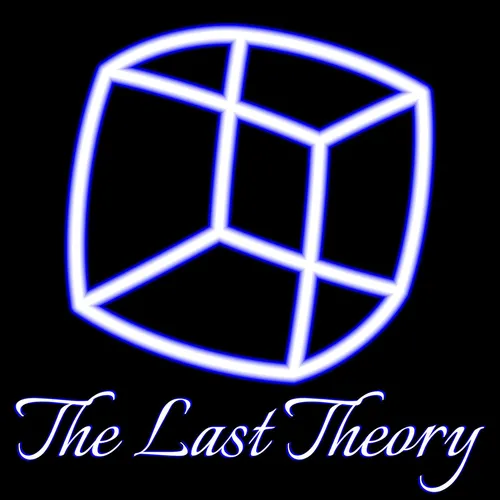
The Last Theory
The Last Theory is an easy-to-follow exploration of what might be the last theory of physics. In 2020, Stephen Wolfram launched the Wolfram Physics Project to find the elusive fundamental theory that explains everything. On The Last Theory podcast, I investigate the implications of Wolfram's ideas and dig into the details of how his universe works. Join me for fresh insights into Wolfram Physics every other week.
- Update frequency
- every 15 days
- Average duration
- 13 minutes
- Episodes
- 75
- Years Active
- 2021 - 2025

Loops and self‑loops in the hypergraph
So many of the most complex and most promising graphs and hypergraphs of Wolfram Physics involve loops and self-loops.
They can play a crucial role in the evolution of graphs and hypergraphs... which …

Living in the fourth dimension with Dugan Hammock
Dugan Hammock lives in the fourth dimension.
As Jonathan Gorard mentioned in our recent conversation on How to draw the hypergraph in Wolfram Physics, Dugan has worked on plotting the evolution of the…

Why I changed my mind about computational irreducibility with Jonathan Gorard
Computational irreducibility means that there are no shortcuts when we apply rules to the hypergraph.
I used to think that our existing theories of physics, such as general relativity and quantum mech…

What’s beyond the universe?
There are two questions about Wolfram Physics I’m asked a lot:
What’s beyond the hypergraph?
And what’s between the nodes and edges of the hypergraph?
There’s a simple answer to this question.
Nothing.
Th…

How to draw the hypergraph in Wolfram Physics with Jonathan Gorard
The hypergraph is the universe.
So if we want to see the universe, we need only draw the hypergraph.
The question is: how?
The nodes and edges of the hypergraph are determined by the rules of Wolfram Ph…

What is the Big Bang in Wolfram’s universe?
What is the Big Bang in Wolfram Physics?
There’s a straightforward answer to that question.
It’s the point in the evolution of the universe where the hypergraph goes from nothing to something.
It’s the …

Graphs v hypergraphs in Wolfram Physics with Jonathan Gorard
Here’s a slightly technical question:
Does Wolfram Physics really need hypergraphs?
Or could it based on graphs instead?
Jonathan Gorard shares some interesting insights into the evolution of Stephen Wo…

Where I’m going with Wolfram Physics in 2023
I’ve been blown away by your response to The Last Theory in 2022.
How am I going to thank you for reading, listening, watching and subscribing?
Well, by bringing you more Wolfram Physics in the New Yea…

Why hypergraphs might be a good model of the universe with Jonathan Gorard
Wolfram Physics is based on hypergraphs.
Why?
What is it about hypergraphs that might make them a better model of the universe than, say, strings of characters, or cellular automata, or Turing machines…

Is Wolfram Physics the next scientific revolution?
For the last few hundred years, all our theories of physics have been mathematical.
If Stephen Wolfram is right, from now on, our most fundamental theories of physics may be computational.
This shift f…

Why I took a chance on Wolfram Physics with Jonathan Gorard
Jonathan Gorard admits that it was a risk, for his academic career, to work on the Wolfram Physics project.
In this third excerpt from my recent conversation with Jonathan, I asked him how he thought …

What is the multiway graph in Wolfram Physics?
In Episode 15: Where to apply Wolfram’s rules? (listen to the audio ⋅ watch the video ⋅ read the article) I introduced a radical idea.
When we’re applying a rule to a graph in Wolfram Physics, there a…

From clockwork to computation in Wolfram Physics with Jonathan Gorard
This is the second of a series of excerpts from my recent conversation with Jonathan Gorard, who was instrumental in the founding of The Wolfram Physics Project.
I asked Jonathan why he found the comp…

Why I don’t like String Theory
In my conversation with Jonathan Gorard about the founding of the Wolfram Physics Project, I said that I don’t like String Theory.
Now, I’ll admit, I don’t really understand String Theory.
It’s highly …

The founding of the Wolfram Physics Project with Jonathan Gorard
In 2019, Jonathan Gorard and Max Piskunov goaded Stephen Wolfram into pursuing his ideas for a new kind of science.
This led to the announcement of The Wolfram Physics Project in 2020.
Last week, I tal…

Hypergraphs are everywhere
Wolfram Physics models the universe as a hypergraph.
Maybe I’m just seeing things, but it seems to me that hypergraphs are everywhere: physics, chemistry, biology, neurology, ecology, sociology, techn…

Unary, binary, ternary, k-ary hyperedges in Wolfram Physics
Here are answers to some fundamental questions about hypergraphs:
A hyperedge can connect any number of nodes: one, two, three, four, seventeen or any other number.
And a hypergraph can include any of …

What is a hypergraph in Wolfram Physics?
In previous episodes, I’ve been simulating Wolfram Physics using graphs.
But you may have come across simulations of Wolfram Physics using hypergraphs.
What’s the difference?
What is a hypergraph?
—
This …

Where to apply Wolfram's rules?
Confession time: I haven’t been entirely honest with you about applying a rule to a graph in Wolfram Physics.
I’ve explained precisely how to apply a rule, but I’ve been strangely silent when it comes…